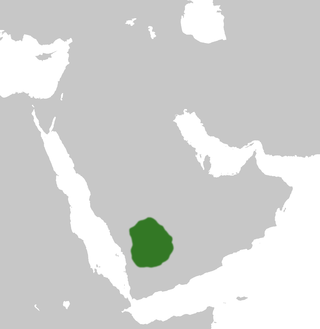Related Research Articles

Indigenous Arabian polytheism, ancient Semitic religions, Christianity, Judaism, Mandaeism, and Zoroastrianism were among the religions in pre-Islamic Arabia.

Al-ʻUzzā was one of the three chief goddesses of Arabian religion in pre-Islamic times and she was worshipped by the pre-Islamic Arabs along with al-Lāt and Manāt. A stone cube at Nakhla was held sacred as part of her cult. She is mentioned in Qur'an 53:19 as being one of the goddesses who people worshipped.
In Arabian mythology, Hubal was a god worshipped in pre-Islamic Arabia, notably by the Quraysh at the Kaaba in Mecca. The god's icon was a human figure believed to control acts of divination, which was performed by tossing arrows before the statue. The direction in which the arrows pointed answered questions asked to Hubal. The specific powers and identity attributed to Hubal are equally unclear.

al-Lat, also spelled Allat, Allatu, and Alilat, is a pre-Islamic Arabian goddess, at one time worshipped under various associations throughout the entire Arabian Peninsula, including Mecca, where she was worshipped alongside Al-Uzza and Manat as one of the daughters of Allah. The word Allat or Elat has been used to refer to various goddesses in the ancient Near East, including the goddess Asherah-Athirat. She also is associated with the Great Goddess.

Dushara, also transliterated as Dusares, is a pre-Islamic Arabian god worshipped by the Nabataeans at Petra and Madain Saleh. Safaitic inscriptions imply he was the son of the goddess Al-Lat, and that he assembled in the heavens with other deities. He is called "Dushara from Petra" in one inscription. Dushara was expected to bring justice if called by the correct ritual.

Hishām ibn al-Kalbī, 737 AD – 819 AD/204 AH, also known as Ibn al-Kalbi, was an Arab historian. His full name was Abu al-Mundhir Hisham ibn Muhammad ibn al-Sa'ib ibn Bishr al-Kalbi. Born in Kufa, he spent much of his life in Baghdad. Like his father, he collected information about the genealogies and history of the ancient Arabs. He was considered unreliable by Hadith scholars.

The Kingdom of Ma'in is an ancient south Arabian kingdom in modern-day Yemen, dating back to the 6th century BCE. It was located along the strip of desert called Ṣayhad by medieval Arab geographers, which is now known as Ramlat al-Sab'atayn. Wadd was the national god of Ma'in.

Manaf was a pre-Islamic Arabian deity and given name that means "elevated". Personal names incorporating the name Manaf such as "Abd Manaf" show that the deity was widespread among the tribes of Quraysh, Hudhayl, and Tamim.

Dumat al-Jandal, also known as Al-Jawf or Al-Jouf, which refers to Wadi Sirhan, is an ancient city of ruins and the historical capital of the Al Jawf Province, today in northwestern Saudi Arabia. It is located 37 km from Sakakah.
According to the Quran, Nasr was a pre-Islamic Arabian deity at the time of the Noah:
"وقالوا لا تذرن آلهتكم ولا تذرن ودا ولا سواعا ولا يغوث ويعوق ونسرا
And they say: Forsake not your gods, nor forsake Wadd, nor Suwāʿ, nor Yaghūth and Yaʿūq and Nasr."[Quran 71:23]
Ruḍāʾ is a deity that was of paramount importance in the Arab pantheon of gods worshipped by the North Arabian tribes of pre-Islamic Arabia.
The Book of Idols, written by the Arab scholar Hisham ibn al-Kalbi (737–819), is the most popular of the Islamic-era works about the gods and rites of pre-Islamic Arab religions. The book portrays pre-Islamic Arabian religion as predominantly polytheistic and guilty of idol worship (idolatry) before the coming of Muhammad, including at the Kaaba, the pre-eminent shrine of Mecca. This, for Ibn al-Kalbi, was a degraded state of religious practice since the pure monotheism that, in Islamic religion, was instituted by Abraham when the Kaaba was founded.
Khalid ibn al-Walid invaded the city of Dumat Al-Jandal in April 631 AD, under the orders of Muhammad to retaliate for the killings of preachers that had previously been sent by him. He also ordered Khalid to destroy an idol that was worshipped by the Bani Kalb tribe.
The Demolition of Dhul-Khalasa occurred in April and May 632 CE, in 10 AH of the Islamic calendar. Sources refer to Dhul-Khalasa,, as both a cult image and as a temple, venerated by some Arabian tribes. Muhammad sent his companion Jarir ibn ʿAbdullah al-Bajali, to destroy the image, leaving the shrine surrounding it in ruins.

Banu 'Akk or simply 'Akk, was one of the main pre-Islamic Arab tribes. The tribe inhabited Yemen in the Jahiliyyah.
'Amr ibn Luhayy was a chief of the Banu Khuza'ah, a tribe originating in pre-Islamic Arabia. 'Amr gained an infamous reputation in Islamic tradition due to him being cited by traditional Arabic sources as the first person to introduce the worship of idols into the Hijaz. He was also known as Abu al-Asnam.

Khuzaymah ibn Mudrikah was one of the ancestors of the Islamic prophet Muhammad, as well as the Kinana and Banu Asad tribes. He was also the brother of Hudhayl, the progenitor of the Banu Hudhayl tribe.

Ilyas ibn Mudar also spelled al-Yas was a pre-Islamic Arabian tribal chief and an ancestor of the Islamic prophet Muhammad. He is the progenitor of the Khindifite tribes, such as the Quraysh. A pioneer of pre-Islamic monotheism, Ilyas ibn Mudar lead a period of religious reform during his rule over the Hijaz to eradicate the worship of idols.
Ka'abas also spelt Ka'bas are the plural term used to describe houses of worship mainly located in the Arabian Peninsula that are cubic in shape and resemble the Kaaba structure from Mecca. They are mainly dedicated to various gods from the Arabian pantheon, although the term has been used to describe some Christian churches built in a similar style in the Arabian Peninsula.
References
- 1 2 Staff, Encyclopaedia Britannica Publishers, Inc (1999). Merriam-Webster's Encyclopedia of World Religions. Merriam-Webster. ISBN 9780877790440.
{{cite book}}: CS1 maint: multiple names: authors list (link) - ↑ Greg Fisher (2015). Arabs and Empire Before Islan. Oxford University Press. p. 118. ISBN 9780199654529.
- ↑ Nancy L. Stair, Amanda Ferguson (2003). A Historical Atlas of Saudi Arabia . Rosen Publishing. p. 22. ISBN 9780823938674.
- 1 2 Dierk Lange (2004). Ancient Kingdoms of West Africa: African-centred and Canaanite-Israelite Perspective; a Collection of Published and Unpublished studies in English and French. Verlag J. H. Röll GmbH. p. 9783897541153. ISBN 9783897541153.
- ↑ Lynn M. Hilton, Hope A. Hilton (1996). Discovering Lehi. Cedar Fort, Inc. p. 179. ISBN 9781462126385.
- ↑ Peter Alpass (2003). The Religious Life of Nabataea. Brill Publishers. p. 120. ISBN 9789004216235.
- ↑ Thomas Patrick Hughes (1995). Dictionary of Islam. Asian Education Services. p. 192. ISBN 9788120606722.
- ↑ Ibn al-Kalbi (translated by Nabith Amin Faris) (2015). Book of Idols. Princeton University Press. p. 9. ISBN 9781400876792.
- ↑ Ibn al-Kalbi (translated by Nabith Amin Faris) (1952). "Book of Idols". Princeton University Press. p. 49.
{{cite web}}: Missing or empty|url=(help) - ↑ William Pickthall, Marmaduke (1967). Islamic culture, Volume 9. Islamic Culture Board. p. 191. ISBN 978-1-142-49174-1. Original is from the University of Virginia
- ↑ ibn al Kalbi, Hisham (1952). The book of idols: being a translation from the Arabic of the Kitāb al-asnām. Princeton University Press. p. 48. ASIN B002G9N1NQ.